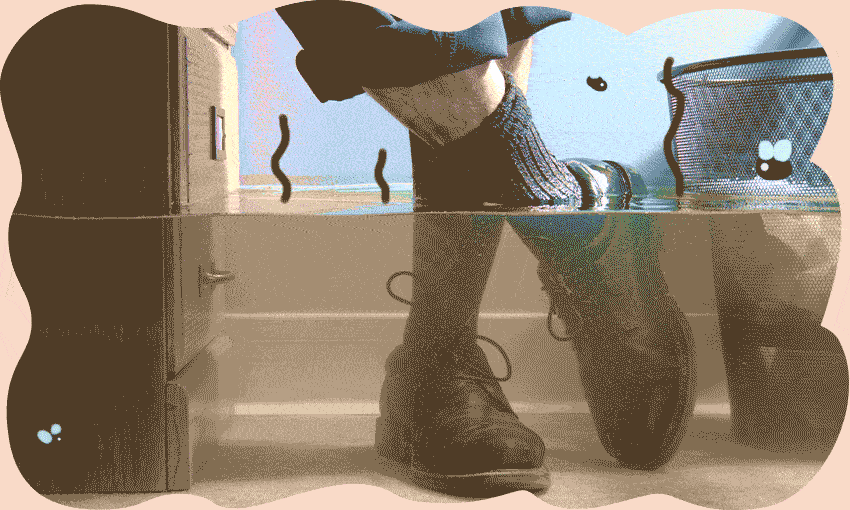When the streets flood, contaminated water gets everywhere – including into your clothes and shoes. Here’s why that matters and what to do next.
Bernard Hickey, journalist and host of podcast When the Facts Change was “rubbernecking” around Auckland on Friday night. There were puddles everywhere. “They certainly didn’t look clean,” Hickey told The Spinoff. Water was gushing down College Hill in central Auckland; it looked like a pipe had burst. But there was no way to avoid the water. His shoes got soaked.
The next morning, Hickey went out for a look again. Auckland’s Domain, once a volcanic crater, was full of temporary, flooded ponds. “There were people splashing around – even kayaking,” he says. He’d put on a pair of dry shoes, but they were promptly inundated.
It wasn’t until Tuesday morning that he noticed what the water had done to his footwear. “There was this awful smell coming from the garage where my shoes were drying,” he says. He made the mistake of sniffing them to check. “It didn’t occur to me that all the greeblies in the water would get into my shoes,” he says, but they sure smelled like they’d had a close encounter of the sewage kind. He threw his shoes in the washing machine, and turned on the dehumidifier to dry them, but he suspects that they might be done for. He thinks it might be time to purchase some gumboots.
After nearly a week of what Hickey calls “two of the three waters mixing,” he knows that he won’t be the only person figuring out what to do with stinky, soggy shoes – especially for those who have been pulling out wet carpet, wading through water to retrieve belongings and assisting with emergency responses.
Flooding means normal water systems are overwhelmed, so water usually destined for sewage treatment can overflow and mingle with stormwater; this graph from Watercare explains how this happens. For this reason floodwaters are full of disease-causing bacteria which can cause gastrointestinal illnesses, skin infections, and respiratory symptoms.
All this tainted water drains into the sea. Several Auckland beaches are known to have been contaminated in the recent flooding; as of Thursday morning, Safeswim has all beaches at a black warning. Standing water will provide a home for mosquitoes and other pests, while damp anything can go rotten.
So if you’ve come into contact with floodwater, what can you do? First, you remove wet clothing, and wash your skin in clean water as quickly as possible to keep yourself safe. Then deal with your soaked apparel.
Peter Croad, owner of the Shoe Sheriff repair shop in Newmarket, Auckland, has several suggestions for people with shoes contaminated by floodwater. While different shoes need different kinds of care, he tells The Spinoff that in general, it’s good to clean and dry shoes as soon as possible. “You don’t want them to get rotten.” Exposure to heat is bad for shoes, as it can make the glue that holds them together fall apart; drying in hot dryers or direct sunlight (if any is available) should be avoided.
Many shoes can be cleaned in an old bucket or laundry tub, with a retired dishwashing brush moved on to its next useful purpose. “Give them a soak and a scrub,” Croad says, although shoes shouldn’t be soaked too long. Leather, in particular, needs attentive care: if it gets wet, it needs to be entirely soaked to avoid water stains. Croad recommends watching YouTube videos on looking after leather, or taking it to a shoe repairer if you have concerns.
Croad says that trainers made from breathable fabric can be cleaned in the washing machine, ideally on a gentle, cold cycle, and if your shoe has a removable footbed, take that out to clean it. For dirty clothes, a heavy duty wash cycle will clean residue. But throwing shoes in the washing machine isn’t without its risks: “I’ve seen some real disasters of shoes in the washing machine,” he says. He recommends using small amounts of mild soap to get filth out of shoes, and drying shoes out of direct light, or, if using an old towel, to be gentle. At the end of the day, though, “some shoes will be a write off” – another strike for the tally of the floods.



